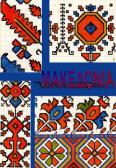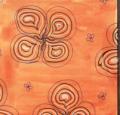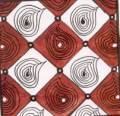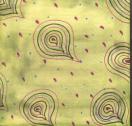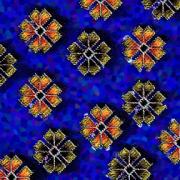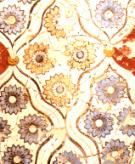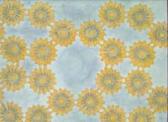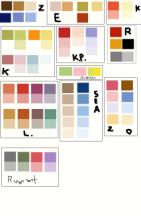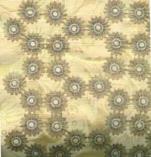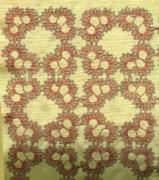Long Distance Training for Rural Women Craft Producers
Margaret Perivoliotis-Chryssovergis
Technological Educational Institute of Athens, Greece
ABSTRACT
This article describes a Hellenic distance learning/e-learning pilot study, focusing on women in remote or rural areas who are professionally or occasionally occupied with the production of artefacts, mainly textiles, without having any education in design, informatics, marketing or management, due to their residential location and life-style constraints. Also proposed is a partial solution to the exclusion and unemployment that is still rife in many East Mediterranean and Middle-East countries. A special educational module was developed using computer and information and communication technology. It was piloted with selected participating rural women, offering them fundamental design education, computer training, and basics on management and marketing.
Keywords: Craft production, Design education, Information and communication technologies, Distance learning, Way out of unemployment
INTRODUCTION
The work presented here focuses on the educational/economical isolation of rural women and the consequent effects on their life. The research field is rural women, most of whom wish to work, or work locally in the production of handicraft items without having any special education or having only a minimal basic one. Women's lack of opportunities and unemployment are still serious drawbacks, global social phenomena that governments are facing, and economic problems that are always effectively present. They result in isolation, exclusion from society, economical extortion, and "disability" in the broadest sense. The majority of rural women declare as their occupation either "farmers" or "housewives", which actually means "unemployed", since it is an occupation that does not offer them any personal income, regardless of the efforts and labour involved. Statistically that means an unemployment rate of 80% of the female rural population of East Mediterranean (TEI Bureaux of Research, 2004). Only in Greece the official total women's unemployment in the country has risen to 21% the last year (Hellenic Bureaux of Statistics, Sept. 2005), while the present national women unemployment is 14.5% (EU statistics, Hellenic Ministry of Economics, Febr. 2006).
The rural location, the different cultural backgrounds and the low educational level have resulted in a low level of professionalism of these women. Lack of know-how in the development of new products and designs, of innovation in product design, of aesthetics and knowledge of the true tradition and heritage, of new technological developments, and the possibilities of reconciliation of the hand-made quality with the new technology, are the main problems of the Greek rural female population that is involved in craft production. Little or nothing is known about the role of information and communications technology.
The project is facing the problem, seeking solutions via design education, training and through promoting the home and cooperative craft industry and production. It also discusses the growing importance of knowledge sharing and the potential contribution that information and communications technologies could make to women inclusiveness. The use of information and communications technology could encourage information flows among women handicrafts, positively contributing to their learning and product innovation.
The aims of the project were to create new opportunities, visions, directions and inspiration, for women in the craft production sector and cooperatives; to support them to adapt new technologies and become more competitive; to assist them penetrate the tourist textile market; to provide a distance-learning program to women in rural/remote areas, members of handicraft cooperatives, and to establish an information/communication network. The network could assist them to combat their isolation and exclusiveness and to improve their efficiency at a national and global level.
The objectives of the project weare to promote interactive craft design research in the university environment; to analyse craft education from a cultural point of view; to facilitate a dialogue on the benefits and limitations of new technology, of information/communications technology, of globalisation on craft design, production and application; to promote the adoption of new strategies in the development of continuous vocational training.
The undertaken research proved that the lack of cultural definition and identity could have, in the long run, a negative effect not only on the development of innovative products, but mainly on the economy of the local craft companies. A special strength of Greece is its cultural heritage, due to its location between East and West, Asia and Europe. Greece is geographically and culturally in between two worlds, with powerful cultural heritage and great emphasis on traditional arts and crafts. So far, local craft production has not succeeded in taking total advantage of this. The project focused on improving the cultural significance of craft items and textiles with the use of new technology. Thus the knowledge of heritage becomes an important marketing tool, since design is one of the basic components of marketing.
THE DEVELOPMENT OF CRAFS THROUGH THE AGES
In the context of manufacturing, we can define production as the entire pre-planned and applied processes and operations that transform materials into predetermined products. The development of these processes constitutes the production as practiced at the manufacturing units. Handicraft, light industrial and industrial companies constitute the manufacturing industry.
At first, craft manufacturing was performed manually. The replacement of manual labour to a greater or lesser degree by mechanical methods resulted in the quantitative improvement of production, in many instances improving the quality while in others causing it to deteriorate. Today, because of global production practices, industries produce goods that are almost identical. On the contrary, goods produced by specialist companies, primarily manually, may look alike but are not identical. They maintain their own aesthetic, character and value, thus remaining unique.
Recently, the craft companies have turned their attention to producing hand-made traditional artefacts, for their unique aesthetic value. The fundamental characteristic of a hand made article is its uniqueness, as opposed to the manufactured ones. Since no two hands can repeat identical motions, these items are not carbon copies. Therefore, in this sense a hand-made item can even be any product that is produced by electric-powered machines, which are guided directly by human hands. A good example of hand-made products is hand-woven and hand-tufted rugs.
The craft business has become a medium of cultural transaction, via the increase of tourism, though it is suffering, in many instances, from lack of identity, due to the imitation or duplication of designs, lack of design quality and lack of production quality, very often due to the producer's low educational level. The coexistence of tourism and handicrafts vanishes in history with the textiles being a great travellers' attraction, since the Egyptian and Aegean era, (Richard, G. 1998). It is evident that travelling was quite limited, at that time, to few intellectuals with curiosity. Democritus, Herodotus, Plato, Aristotle, Ptolemy were some of the well-known travellers of the ancient world. It is a fact that via those travellers curiosity, fabulous hand made pottery and rare hand made textiles of the ancient world moved from country to country, thus inspiring local designers and craftsmen not only for the creation for new artefacts, but also of new forms of design and decoration. Thus Culture was transplanted from India and China to Egypt and Rome, and from the southern Mediterranean countries to northern European and Asian ones, inspiring local masterpieces (Perivoliotis, M. 1998).
The last two centuries travellers' attraction by local handicrafts has been more evident. Their interest for traditional textiles is a phenomenon with increasing sequence not only for those of the exotic countries production, but also for all tourist places. A determining parameter for the 20 th century is the lightweight of most of the textiles and their by-products, making their transportation easy, especially with our modern air-transport, and thus textiles have become a modern medium of cultural data transaction among nations and people.
Greek Craft Cooperatives
Cooperatives are particularly significant for the Greek economy, with 90% of businesses having less than 15 employees, of which 95% are women, of which 85% are producing textiles and fibre products, ( Hellenic Organization of Small and Medium Enterprises, 2003). Textile cooperatives are the only source of employment growth among women in certain remote areas .
A cooperative is a society with common activities and common economical aims among its members, pursuing their economical and life style improvement. It has a legal face, requires seven minimum voting members, general assembly and director. Their target is the improvement of the member's ability to produce, the maximization of sales, the minimization of product cost, the optimisation of work conditions. The cooperative offers an economical, social and organizational framing that includes common purchase of row materials, common sales of craft-products, common structure of modern production units and common presentation of the products.
Handicrafts textile cooperatives retain a small, but very important "niche" in the global market, because they are linked to the retention of regional and local traditions, the provision of jobs, especially for women in rural and remote areas, and the preservation of a level of quality and exclusivity, which cannot be found in manufactured items. Securing jobs in the handicrafts sector has, therefore, a social and cultural significance, besides its economic one for rural/remote areas, especially for the developing countries, where it is a possible way to save women from becoming economic refugees.
Craft producers fall basically into two groups: professional producers who earn their living from sales, and those who produce craft items along-side another occupation, generally farming. The first group of producers is open to new developments, has a good distribution network, has some kind of education and training and high level of interest in seeing and learning modern techniques and design improvements. The second group draws its members mainly from among women, and craft production is a source of additional income for many of them. The basic outlet of handicraft women is the local market, despite the fact that foreign markets appear to be interested in handicraft products. Their ability to penetrate new markets is non-existent with complete lack of knowledge concerning the means that can be used in order to approach the consumers (Phillipoulis, A., 1996).
Some of them collaborate with tourism retail shops but not on a regular basis. In many cases, their textile products, produced in their spare time during the long winter evenings, along with cooking, cleaning, bringing up children and attending to domestic animals, are sold right outside their own homes which also operate as exhibition stores. In Greece only one women's cooperative is exporting to foreign countries and collaborates with wholesalers (Hellenic Organization of Small and Medium Enterprises, (Ministry of Development, 2002).
Governments wish to promote the handicraft business and a simple way is women's work-placement in handicraft production cooperatives, mainly for the tourism business, which could be composed and run by them. Basic constraints of this simplified solution are the training and educational deficiencies of the majority of rural women and the fact that the most productive ones will be middle aged, those past child bearing.
Another important issue is the variety of operational modes that characterize the handicraft industry and the training requirements involved. External support from experts could be a prompt and effective way to remedy these deficiencies, but appears to be in general financially prohibitive. Improvement of skills up to a certain level, especially through distance education and training, provided at home or at the workplace, is the most realistic way for these women to become gradually more competitive and survive.
The Greek cooperatives are producing mainly traditional items for local and tourism use. Their range includes all kinds of hand-made items but sales are strongly related to "useful" items, particularly textiles. The textile production was, and still is, mainly a job for women, and the most time consuming one they undertake. Local products are used and the so produced artefacts are sold to local people or visitors. Techniques and equipment are largely handed down through generations. Unfortunately designs, which have been handed down from mother to daughter and reflect local history, religion and customs, have been often debased during the last few decades, due to uncontrolled production. Globalisation is an extremely broad and complex phenomenon that undoubtedly represents a threat to cultural identity and diversity. Craft production is a form of culture that faces the threat of loosing its identity and diversity if it submits to the culture industry. Deep knowledge of local tradition and vision could be strong supports against defeatism.
THE CASE STUDY
The case study was undertaken and completed by the research team of Technological Educational Institute, (TEI) of Athens, Textile Design Studio. In the present case study participated three design professors, one professor of electronics, four practical trainees, ten final degree projects, ten women cooperatives from selected pilot regions of Greece, covering the mainland, from Thrace to Peloponnesse, and the Ionian and Aegean islands. The students, within the framework of their final degree projects, undertook research, under the guidance of their educators, on:
- Handicraft women , their products, designs, working conditions and skill needs. The research was curried out to the ten selected pilot regions of Greece,
- Traditional designs, by creating a database from museums collections that was included in the module as a possible source of inspirations,
- Local craft production , the ways of production, the constrains, the marketing, the outlets,
- Analysis on the possibilities of product/design innovation/diversification.
The steps or the case study consisted of:
- Two (2) years of investigation into the workings of the craft production industry and women craft workers in rural areas;
- One (1) year for the completion of the long distance learning module;
- One (1) year for dissemination of the module within ten special training seminars, offered all free for the ten participating handicraft women cooperatives, tutored by the participating design professors.
The Case Study Questionnaire
An important element was to improve the marketing of handicraft products. In order to support the marketing effort of local women producers, a major survey was conducted on craft business to the ten pilot regions. The research was carried out among rural women craft producers, some located in remote areas, self-employed or within small cooperatives, oriented to domestic rather than foreign markets. Their production, offering them minimal basic income, was limited to wool and silk woven products, in the traditional way, often in loom-woven quality and coloured, in most cases, with natural dyes from local plants.
The researchers, in order to obtain an accurate image of problems, needs, necessities, so that they could come with possible solutions, asked the participating women to complete a shelf evaluation questionnaire. The addressed questions were on their general and art/design education, craft-type of production, product inspirations/prototypes, quantity of production, target groups of purchasers, type of quality control - if any, their skill needs, problems, required solutions. The questionnaires were organized under the following headings and sections:
Who are these women and where is this cooperative?
- What type of craft production?
- What is the size of the cooperative and the organisational profile?
- Who are the women involved in craft production?
- Where is the cooperative based?
- What is the size of its operation?
- Who does supply them?
- To whom do they sell?
- Where do they distribute?
What do they produce?
- The type of products the company produce (textile qualities, household, clothing, fashion, fibre products, etc),
- How specialized or diverse is the product range?
How do they produce these products?
- How are the products designed?
- How are the products developed for the production stage?
- How is quality controlled within their production system?
- What types of production systems are they using?
Commentary
- Any comments that need to be added,
- Other activities of these women that need to be added,
- Are there any confidential restrictions to publishing this information or using for educational purposes?
Research process
The operational problems these women were facing were many and the efforts were focused on pointing them out and propose possible solutions. Certainly it is unrealistic for all to receive training in design and all the vital operations of an enterprise, and the low educational level of rural women makes this even more difficult. The research was supplemented by selected data from four governmental and semi-governmental associations.
Two particular difficulties were encountered during the survey. The first difficulty stemmed from their rural location and their different cultural backgrounds. This required an additional effort for the effective coordination of the project and attention to cultural differences in interpreting the material and information collected.
The second difficulty stemmed from their low level of professionalism and relatively low educational level, making them unable to articulate their needs and training requirements well. It was difficult for many to discuss concepts and practices that are common knowledge in any business environment, such as management and marketing.
Research data obtained
Research has shown that there are many factors responsible for the exclusiveness and isolation of women handicraft producers. The main findings can be summarized as follows:
- The location of women handicraft producers, away from the urban centres, in remote rural and often isolated areas,
- Lack of know-how in the development of new designs and products,
- Lack of innovation in handicraft products,
- Lack of aesthetics and knowledge of the true tradition and heritage,
- Low-level design and basic education,
- Lack of know-how of management and marketing,
- Lack of cooperative spirit,
- Lack of innovating products appealing to purchasers.
The main findings in relation to the women training needs could be summarized as follows:
In Management
- Lack of cooperative spirit and entrepreneurship,
- Lack of motivation and effective human resources management,
- Inability to deal effectively with accounting and financial management (cash flow, cost analysis).
In Production Organization
- Lack of rational allocation of tasks,
- Inadequate planning and monitoring of production,
- Stock management,
- Time management.
In Marketing
- Lack of understanding of market research,
- Lack of distribution networks,
- Inadequate implementation of sales promotion methods.
In Technology
- Lack of knowledge of new production systems/technologies, of computer and information technologies,
- Slow adjustment of production to new techniques of accounting and management,
- Difficult coexistence of hand-made quality with new technology.
In Design
- Lack of know-how in the development of new products and designs,
- Lack of innovation in product design,
- Lack of aesthetics and knowledge of the true tradition and heritage.
Managerial skills were examined by looking at the following two aspects of managerial capacity:
- The level of organizational development or organizational competence of the handicraft cooperatives,
- The level of management competence with regard to leadership.
Analysis of Data Overall and in all respects, findings were very disappointing. External support from experts could possibly remedy such deficiencies and the support of private consultants could also be valuable for the introduction of information and communication technology and the use of computers in the design process, but appears to be generally financially prohibitive. Their location away from urban centres, in remote rural areas, makes it even more difficult. It is also important for all women craft producers to obtain basic awareness of the existence of information and communication technology (Frangopoulos, S. 1997). Most women are working with the traditional designs and means of production. The economic and operational structure of handicrafts industry, combined with the demands of the tourism market for tradition, does not allow them radical interventions. They are lacking skills either in terms of production for the market or in terms of pricing, market and communication.
Findings
The majority of the interviewed women, in 7 out of 10 cooperatives, do not have the ability to investigate the demand for their products and identify appropriate markets, including the "niche" markets that exist for high quality handcrafted textiles. In 5 out of 10 cooperatives management competence could be rated as definitely inadequate, and only in two it was considered as rather adequate. Organizational competence was found to correlate strongly with management competence, and in most cases, there was hardly a proper manager's role established and functioning within the organization of the cooperative. Elected chairperson who took on the role of director had a low level of general education and lacked basic management skills and know-how to perform with minimal success a manager's role.
Some thought that management capacity could be strengthened by using external consultants or by hiring a manager. However, external consultants or a hired manager cannot substitute the need for a cooperative leadership that has a minimum management competence, and anyway that would be financially preventing. This situation underlined the need for a proper management function, which would include accounting and finance management.
In most women cooperatives (8 out of 10) there was a task allocation system that takes account of the particular production skills of each member. However, since work allocation concerns only production, the managerial, design and marketing processes failed to be active. It was necessary for cooperatives to allocate work responsibilities not only in relation to the production processes, but also to the managerial, design and marketing processes.
A basic characteristic of women handicrafts cooperatives was that they are strictly limited to the production of large size traditional textiles or textile products, with high cost. Although it is very important to keep the traditional character, it is also important to re-orientate their production towards new products or designs, which can be produced effectively with low cost, are light weighed and appealing to air-travelling tourists. This is a question of product diversification and the development of a range of products that may be addressed to different target groups (specialist, exclusive tourists, air-travelling tourists and everyday users).
The most important skills deficiencies were in the areas of education, design renovation and management. Their design education is limited to what is offered at school, which is to say none, or minimal, or whatever is handed down to them through tradition, with the artistic creation depending on self-made decisions of self-employed artisans. Actually 90% of them have no specialized education, 50 % of them have a high school (three years) diploma, 20 % have lyceum diploma (six years post elementary school education), 90 % were unable to produce new designs or run a business, but 100 % wish some kind for training in designing, 60 % in pricing, 50 % in marketing, 70 % in accounting, 50 % in management, 40 % in informatics, and 30 %, a small but significant minority, declared that they need an external expert in order to cover their needs. Almost all women (in 9 out of 10 cooperatives) wish and believe that it is possible to introduce information and communication technologies because it could support many activities, such as distance education, world-wide information, design evolution, management and marketing, that at the present time cannot be easily developed. The majority regards their equipment as inadequate and require the introduction of computers and computer-assisted design.
Interpretation
The first conclusion, concerning rural women handicrafts cooperatives is the lack of systematic work organization. Cooperatives should select members or hire external employees-experts to undertake the following operations:
- Management (human resources, accounting and finance)
- Production (organization, planning and monitoring the quality control)
- Marketing (design - product development/diversification, sales promotion, distribution networks).
The second conclusion is the difficulty for cooperative members to attend training courses for all the issues that are vital for them.
In order to improve the design ability of rural women handicrafts, the research team offered them a basic long-distance/e-learning educational methodology that would meet their skill needs, regardless of their operational/educational differences and location, with basic, simplified, lessons on design, colour, design development, communication technology, marketing know-how. The module was offered in CDs, a form suitable for distance learning and e-learning, hard copies – preferred by elder women, and within the web site of TEI. A database on cultural heritage was also included for the common use of all the participating women.
THE MODULE
The special training package was offered to the pilot women craft producers, assisted by the development of a simple Computer Information/Communication System, an email and Internet network. A simple database was created within the Technological Educational Institute ( TEI) web site offering examples and inspirations on design and craft products based on traditional prototypes. Since it was of the utmost importance to them to be able to run a modern business, very simple training modules on entrepreneurship (management, accounting, production, marketing) and technology (computer usage) were included, designed by the participating professor of electronics (figure 1). It is a special, for women handicraft producers', multi-skill development offering them distance learning accessible in many forms, including free access through the web.
The objectives of the package were:
- The development of a user-friendly training program, which responds to the needs of unemployed women or uneducated female members of cooperatives who live in remote areas providing vocational training through distance learning in the design and production sector.
- The possibility for the development of a network that would support the exchange of design information and technological know-how between women artisans and craft producers, thus promoting the continuous, on the job, training.
The training program covers topics that refer to designing and producing quality craft products, mainly textiles, in the organisation of a craft business and in the development of entrepreneurship. The context of the training program includes:
- Artistic design (Colour, Design, Application),
- Informatics (Computer Usage),
- Entrepreneurship (Management – Marketing - Production)
)

Figure 1: The three topics of the Training Module, with their sub-topics. Basic principles offered with a very simple language, methodology and many examples.
The module used a very simple language and methodology, adapted to the women's educational level, assisted with visual presentations and examples from their culture and heritage, in order to make it more educational and attractive. Simplified, basic knowledge in all areas was offered, particularly in the artistic field, hoping to inspire the imagination and creativity that has for so many generations nourished local traditional cultures. Simple lessons on the principles of design, the use of colours, the traditional designs and media of production, fibres and textiles were included in Artistic Design, (figure 2). Step-by-step examples of design development, colour combinations and new product development were also part of it, all inspired by the well-known traditional prototypes. Inspirations were always presented together with the final designs/products in order to offer a paradigm on thinking, imagining, designing, creating. Simple examples of computer use were offered, together with basics on management, marketing and production, all with examples (figures 3, 4). The participating design professors guided the degree students to select the cultural data, create the design examples of the module, develop the design/colour methodology, and delivered the educational module by tutoring it with seminars and via the web.
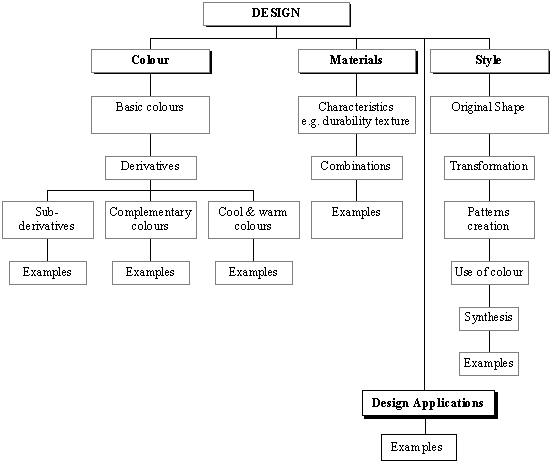
Figure 2: The detailed structure of the Artistic Design with all the included sub-sections in detail
The reasons to move from traditional teaching or training processes towards distance learning were many. The vital one was the location of the participants and their educational differences. Additionally, for the Artistic Design field the usual learning way is the individual, studio-based culture, with design learners preferring a practical, visual, learning approach. Design learners are also 'visual thinkers'. They respond well to materials/activities that provide them with the stimulus to create something. The module was designed with the qualities of being attractive, colourful, practical and simple, in such a way that learners with different backgrounds or learning disabilities and preferred learning approaches will feel motivated and gain the best possible learning results from it. Since traditionally, the most important type of learning resources used to be paper-based, print-based materials were offered. Actually it was a challenge for the research team to determine the women preferred learning approaches/necessities and related social and cultural issues, and to design the right learning environment to meet their needs.
Figure 3: Examples of the proposed design methodology and computer-design work, as presented in the module with step-by-step colour/design examples. They are paradigms of the different ways/possibilities and colour combinations an inspiration can evolve : a , inspiration derives from the northern Greece traditional embroidery. The lower right flowers are simplified, b , and evolved in different ways and colours, c, d, e. An example of computer designing is additionally offered, f . The participating students of TEI Textile Design Studio, under the auspices of the design professors, created all designs.
Figure 4: Examples of the proposed design methodology, colour combinations and textile production as followed by the participating cooperatives with the assistance of the research team : a inspiration, b hand design, c chart of possible colour combinations, d, e, textiles produced. Participating students of TEI Textile Design Studio, under the auspices of the design professors, created the design work and colour chart. Participating women produced the textiles.
The Artistic Design part is trying to help women craft producers to visualize evolutional, innovative design possibilities of well known and overworked designs, to open up their minds in designing, in new technologies and possibilities, (figure 5), and not to force specific designs and applications on them. The approach adapted media and technology and computer-aided design work that were of interest to most of them. The module minimizes their working time, offers many possibilities, has versatility and has the advantage of offering what the market demands today, without thrusting aside human inspiration and creativity, nor personal originality and uniqueness. The case study indicated, as the best approach the adaptation of hard copies for those of elder ages and lower education, computers, CDs, the Internet and e-mailing for the younger and more educated ones. The benefits of the use of these systems for supporting rural women learning are opportunities that would not otherwise exist: flexibility, easy communication, time for learners' reflection, interaction over time and space.
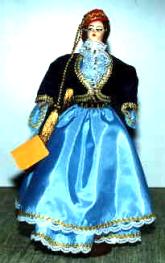 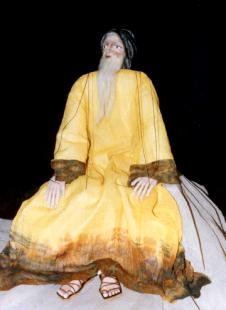 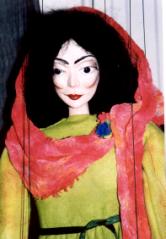
Figure 5: Examples of product diversification: Proposed design/product innovation/ re-orientation: b, c new dolls and marionettes, inspired by, and representing, the Greek mythology and local myths. They are lightweight, suitable for air- travelling tourists, children souvenirs, (local and international), and local theatrical children performances. They are new products that open new markets including the tourist, the local and the stage ones. They were proposed and designed by the participating students, in order to replace the overworked traditional dolls, a, and produced by the participating cooperatives.
CONCLUSIONS
The proposed design work, by being accessible through the Web, provides a suitable forum for an exchange of cultural information and design experiences, and where design/design ideas/inspirations have been traditionally articulated in print can be also accessible via the Web. The establishment of future thematic networks was also proposed. It can enable the creation of networks for cooperation and utilization of synergies and will support rural women producers to communicate, since if isolated, might be neglected or not utilized in terms of their advantages.
Linking up with the site all interested women could find ways for:
- Development of new products and designs, from the very many offered, step-by-step, examples together with the colour/design methodology,
- Innovation in their product designing, by adapting to the proposed possibilities of product diversification,
- Paradigms on aesthetic developments among the many offered examples of right and wrong colour combinations and design developments,
- Knowledge of the true tradition and heritage from the simplified lessons on tradition and history of Hellenic Design, and from the included cultural data,
- Basic awareness of new technology, via the step-by-step lessons of computer usage,
- Basic awareness of marketing from the simple, with examples, marketing principals,
- Basic awareness of management, offered with simplified rules and basic examples
All the above can offer them:
- New Opportunities to expand production, activities, inclusiveness into the new market system,
- New Visions for new products/designs,
- New Skills, to enable them to create modern, appealing to a great variety of customers, products, to assist them to stay alive in the market, or become competitive under the immense pressure posed upon them by external production changes and the expansion of high technology applications,
- New Technologies, for efficient and less time consuming designing/production,
- New Directions to new market, local and international,
- New working, producing, selling Environments
The cooperative women of the ten pilot regions produced craft items, selected from the participating students design creations, following the proposed colour/design methodology, (figures 3, 4, 5). The productions were decided with the assistance of the research team and with criteria to fulfil modern demands, bear the local identity, have high quality, adapt to the rules of market, agree with the tourists' taste, in a search for balance between the lowest possible production costs, the protection of craft products competitiveness, and the maintenance of a good image that satisfy consumers and pressure groups. The so produced craft products were evaluated on the aforementioned parameters by the research team and the National Craft Bureaux.
RESULTS
The unique feature of this project is that it provides the opportunity for rural women to explore craft design and production issues from their home base, enabling effective sourcing of design information. The module and the TEI web site provided opportunities to women in remote/rural areas to obtain access to develop the skills necessary to become competitive , to draw them from their economical isolation, to help them succeed inclusiveness in the modern world, and to promote equality of opportunity for women workers.
The delivering of distance learning transferred design, introduced ways of creating culture, value, social and environmental quality. The project pointed to the participants the importance of cultural continuity and cultural/historic resources, of cultural and social exchanges that derive from tourism and of local processes and materials, and of the craft production to the regional growth in the concept of economic and social development .
The three parts of the module were tested and evaluated by the TEI research team and the National Craft Bureaux. New designs and new products resulted from the adoption of the module. New technology was added in their production system. The Hellenic Organization of Small and Medium Enterprises, (EOMMEX), together with the Ministry of Employment and the Organization of Women Equal Rights have offered financial support, in the form of long-lasting loans, to all women cooperatives in order to obtain the necessary New Technology.
The ten participating cooperatives transferred production towards new products/designs; all adapted the use of computers and Internet into their work environment, use accountants to improve their finance, and members of three cooperatives are now using computers for designing purposes. Collaboration between them and professional designers has started in a network form. Greek professional designers are interested in the handicraft tourist business and the production of handicraft items. They are assisting them in designing and offer outlets for their products into the Greek households. This, in the long run, will stimulate provincial youngsters to become involved, take up positions in their regional businesses, and offer financial opportunities and inclusiveness to women and people in remote/rural areas.
The Athens Olympic games offered to women cooperatives new opportunities and directions in the tourist market. They realised the importance of high quality, with local identity, craft products. The retail sales of tourist products during this period have passed the €728 million, ( Hellenic Ministry of Economics, 2005), of which a great part was for local high quality craft textiles and cultural products. Totally more than fifty Greek handicraft cooperatives have interested in the module. They were benefited from its study, either directly compiling information, or indirectly, by being able to use the module for designing purposes.
The module has opened opportunities and possibilities for women, and at the same time has assisted in bringing more up to date knowledge and experience in the craft production environment. In times of global networking, increasing competition, persisting unresolved economic problems, women handicraft producers must endeavour, more than ever before, to link their tasks to wider objectives, if they wish to escape from exclusives and disability and to obtain the inclusiveness they deserve.
REFERENCES
Bhamra, T. (1998), "A Cross–sectional Approach to New Product Development", Design Journal, 3/1998 .
Britton, A. (1991), "The manipulation of skills on the outer limits on function, craft, skills, and imagination", Crafts Council .
Bonk, C. J. (2002), Online training in an online world , Bloomington.
Bonk, R. & A. Wisher, A. (2000), Applying collaborative and e-learning tools to military distance learning: A research framework , Technical Report, US Army Research Institute for the Behavioral and Social Sciences, No 1107/2000.
Boshier, R. (1997), Best and worst dressed web courses: Strutting into the 21st Century in comfort and style, Distance Education , Vol. 18, No. 2/1997, pp. 327-348.
Byun, K. & Hallett, C. (2000), Supporting instructors in the creation of online distance education courses: Lessons learned, Educational Technology, Vol. 40, No 5/2000, pp.57-60.
Carr, S. (2000), As distance education comes of age, the challenge is keeping the students, The Chronicle of Higher Education, Vol. 46, No 23/2000, pp. 39-41.
Casey, M. (1999), "My Disillusionment with Popular Culture", ARTTU, 3 .
Chamber of industry, (1999), "Data on Hellenic textile manufactures".
Champagne, M. V. & Wisher, R. A. (2005), Design considerations for distance learning evaluations .
Crafts Council, (1999), "The crafts and the economy".
Daniel, J. S. & Marquis , C . (1997), Interaction and independence: Getting the mixture right, Teaching at a Distance, 14/1997, pp. 29-44.
Design Council, (1998), "Design to compete".
Druker, P. (1974), "Management: Tasks, Responsibilities, Practices", Harper Row , NewYork.
Fiore & Kimple, P. (1997), "Understanding aesthetics", Fairchild Publications.
Frangopoulos, S. (1997), "Informatics", TEI of Athens.
Harrington, L. (1997), Technology Works Best When It Serves Clear Educational Goals, Harvard Education Letter Vol. 13, No. 6/1997, pp. 1-5.
Harrison, N. & Bergen, C. (2000), Some design strategies for developing an online course, Educational Technology, Vol. 40, No 1/2000, pp. 57-60.
Hawkins, J. Spielvogel, E. & Panush, E. M. (1998), National Study Tour of District Technology Integration: Summary Report , EDC/Center for Children and Technology Report .
Hellenic Bureaux of Statistics, 2005.
Hellenic Ministry of Development, 2002.
Hellenic Ministry of Economics, (2005), Statistics on Athens Olympic Games.
Hellenic Ministry of Economics, (2006), EU Statistics on unemployment.
Hellenic Organization of Small and Medium Enterprises, (2003), "Data on cooperatives".
Hellenic Organization of Small and Medium Enterprises, (2000), "The Greek Cooperatives' File", Ministry of Development.
Hellenic Organization of Provision, (1999), Handicrafts.
Honey, M. Culp, K. & Carrigg, F. (1999), Perspectives on Technology and Education Research: Lessons from the Past and Present, U.S. Department of Education, Secretary's Conference on Educational Technology Proceedings .
Horton, W. (2001), Evaluating e-learning , American Society for Training & Development.
Howe, T. & Dillon, P. (2001), "Cultural Niche and the Context of Craft, Design and Fine Art", Design Journal, No 3/2001, p. 50-56.
Institute of Hellenic Garments, (2002), "Export-Import Data".
Institute of Industrial Research (1999), "The Greek textile and clothing manufacture companies".
Jerard, B. & Husband, J. (1999), "Design and Ethnicity, West Midlands Clothing Enterprises", Design Journal, No. 1/1999.
Kalviainen M., (1998), "The professionally accepted Good Product", Design Journal, 1998/3, pp. 30-43.
King B. & Spring M. (2001), "The Design Process in its National/Regional Context", Design Journal, No 3/2001, p. 4-18.
Knott, C. A., (1994), "Crafts in the 1990's", Crafts Council.
Murphy, D. Jamieson, P. & Webster, L. (1999), What is flexible learning ? Flexible Learning Guide Number 1 , Centre for Higher Education Development, Monash University.
National Statistics Services, (2000),"Greek textile production data in the post war period".
Norman, D. (1998), The Design of Everyday Things , The MIT Press.
Perivoliotis, M. C., (1998), "Textile and Tourism", ATLAS Conference proceedings.
Phillipoulis, A., (1996) "Entrepreneurship", TEI of Athens.
Press, M. & Cusworth, A. (1997), "A new vision in the making: Exploring the value of craft education in the information age", Design Journal, No 1/1997, p. 12-29.
Ranson, B. (1999), "Craftwork, Ideology and the craft lifecycle", Journal of design history, No 2/1989.
Rhoades, B. & Sweeney, K. (2004), "Changes in the teaching and learning process in a complex education system", Necsi Research projects.
Richard, G. (1998), "Textile Tourists in European Periphery", ATLAS Conference proceedings.
Rockman, S. (2004), Leader's Guide to Education Technology , National School Board Foundation's.
Rodgers, P. & Clarkson, P.J. (1998), "An Investigation and Review of the knowledge needs of Designers in SMEs", Design Journal, No 3/1998, p.p. 16-29.
Rosenkrans, G. L. (2000), Assessment of the adult student's progress in an online environment, The Internet and Higher Education , No 2/2000, p.p. 145-160.
Sandholtz, J. Rignstaff, C. & Dwyer, D. (1998), Factors That Affect the Effective Use of Technology for Teaching and Learning: Lessons Learned from the SEIR-TEC Intensive Site Schools , Greensboro, SEIR-TEC.
Schindler, M. (2000), "The Textile Routs Project - The Austrian Contribution", Textile Forum, 4/2000.
Setamaa, P. (2000), "Visualizing and Sketching in the Design Process", Design Journal, 3/2000.
Simon, S. (1998), "How can you design products that are usable and desirable?" ARTTU, 5.
Sotamaa, Y. (1999), "Handicrafts and the Passion for Quality", ARTTU, 3.
Starr, P. (1996), Computing Our Way to Educational Reform, American Prospect, No 27/1996, pp. 50-60.
Sterk, B. (2000), "New departures in textiles", Textile Forum, No. 2/2000.
Svengren, L. (1997), "Industrial Design as a strategic resource", Design Journal, No 1/1997, 3-11.
TEI Bureaux of Research, (2004), "Women Inclusiveness".
Additional information on local, European and global textile issues was obtained from the listed Web sites. They were included in the module as a source of global data.
http://europa.eu.int/comm/enterprise/textile/statistics.htm
Textile and clothing industry in the EU: A survey
http://www.euratex.org/
http://www.asbci.co.uk/
http://www.itaaonline.org/
http://www.fgi.org/
http://www.aedt.org/
http://www.apparelsearch.com/associations.htm
http://www.trendselection.it/
http://www.apparel.com.gt/
http://www.ilo.org/public/english/dialogue/sector/papers/bzethics/index.htm
Copyright for articles published in this journal is retained by the authors, with first publication rights granted to the journal. By virtue of their appearance in this open access journal, articles are free to use, with proper attribution, in educational and other non-commercial settings.
Original article at: http://ijedict.dec.uwi.edu//viewarticle.php?id=168&layout=html
|


